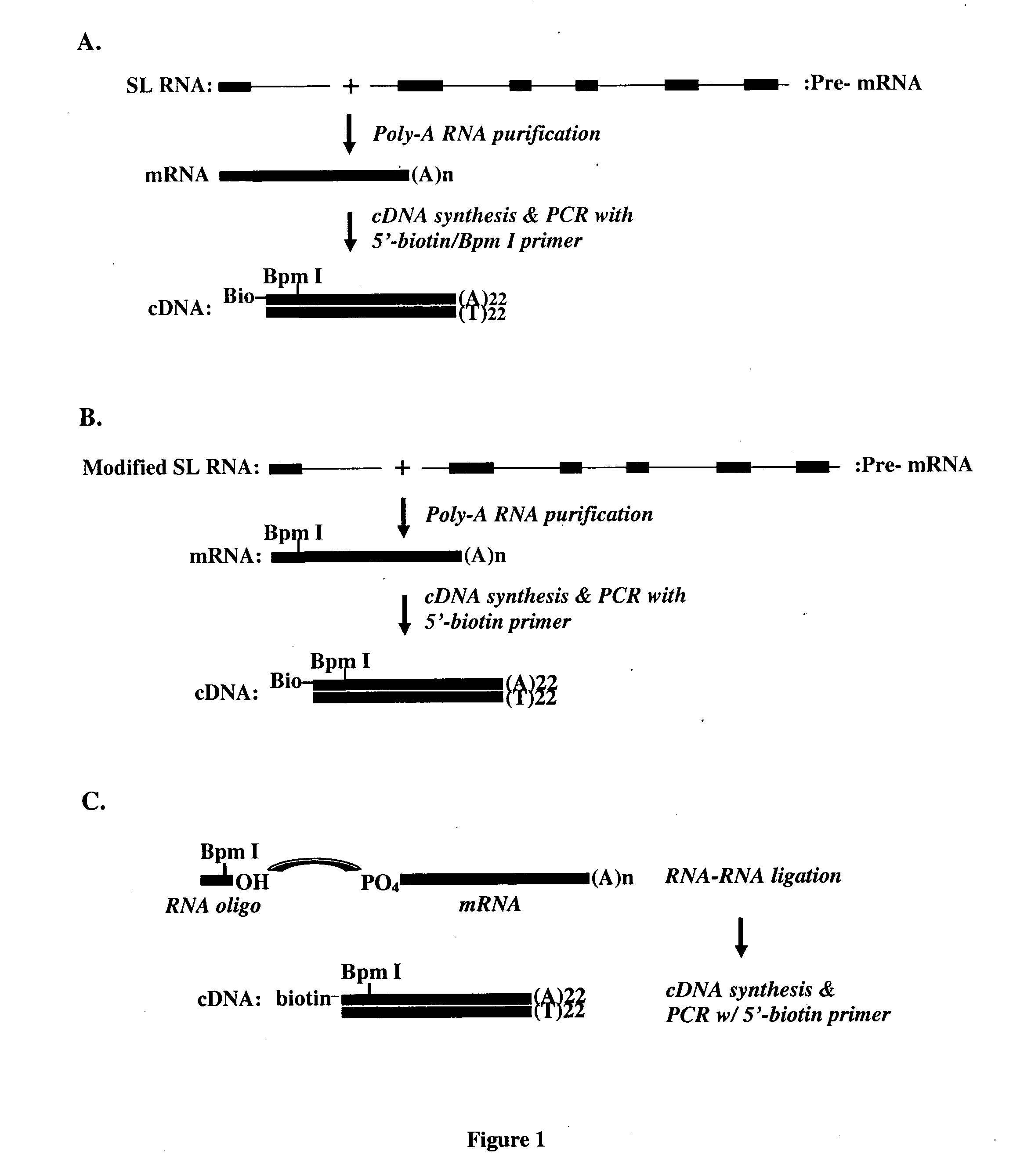Methods and compositions relating to 5'-chimeric ribonucleic acids
a technology of chimeric ribonucleic acids and compositions, applied in the field of methods and compositions relating to chimeric ribonucleic acids, can solve the problems of limited understanding of complexity and diversity of the completed genome, the process of identifying the complete set of transcripts produced by an organism has proved to be technically difficult, and the rate limitation step is limited. , to prevent cryptic aberrant trans-splicing reactions, the effect of little effect on the splicing
- Summary
- Abstract
- Description
- Claims
- Application Information
AI Technical Summary
Benefits of technology
Problems solved by technology
Method used
Image
Examples
example 1
TEC-RED Analysis to Identify 5'-ends of RNA Messages in C. elegans and C. briggsae
[0139] TEC-RED was performed successfully in nematode worms to identify the 5' ends of RNAs. As shown below, this technique permits the identification of alternate transcript initiation sites, previously unknown splice variants, previously unknown 5'-ends of known genes and the 5'-ends of previously unknown genes.
[0140] At least 80% of mRNAs in C. elegans and C. briggsae contain SL-1 or SL-2 exons, added by a trans-splicing process. Generally speaking, when pre-mRNAs become mRNAs by cis-splicing and poly-A addition at the 3'-end of the RNA, a SL-1 or SL-2 RNA exon is trans-spliced into the 5'-end of many pre-mRNAs.
[0141] In this example of TEC-RED, in brief, the common trans-spliced exon sequence serves as a known sequence at the 5' end of trans-spliced transcripts that can be used to design primers to direct the synthesis of cDNAs containing the 5' end of acceptor RNAs. In addition, the primer sequenc...
example 2
Cell-Based Trans-Splicing Reaction with a Modified SL-1 RNA (mSL-1)
[0148] The intron sequence of the C. elegans SL-1 RNA is involved in proper trans-splicing reactions, but partial deletions and site-directed mutagenesis of exon sequence do not significantly perturb the trans-splicing reaction. As demonstrated here, even highly modified sequences of the SL-1 exon could perform trans-splicing properly. A modified SL-1 exon could be used, for example, to introduce a tagging restriction enzyme site that produces tags larger than 14 bp or to introduce leader sequence encoding a useful polypeptide tag.
[0149] The modified SL-1 (mSL-1) RNA in C. elegans was expressed by an extrachromosomal array. This mSL-1 RNA contains a modified exon sequence (50 bp long sequence different from the original 22 bp long exon sequence) and the original intron sequence of SL-1 RNA. To test whether this mSL-1 RNA could trans-splice specifically to SL-1 acceptable mRNAs, the occurrence of in vivo trans-splicin...
example 3
Separation of mSL-1 RNA and Trans-Spliced RNAs by Exon Affinity Chromatography
[0150] As an additional or alternate method for obtaining RNAs having a trans-splicing exon sequence, a system for affinity purification was developed, based on the sequence of the trans-splicing exon. As shown in FIG. 9, RNA transcripts containing mSL-1 exon at their 5'-end were purified by affinity chromatography, using a column containing oligonucleotide sequences that are complementary to the mSL-1 exon sequence. The purified RNA was subsequently amplified by RT-PCR, and the products were sequenced, following their cloning into a sequencing vector. The sequencing results showed that 90% of the purified transcripts were mSL-1 RNA and the other 10% represented the trans-spliced mRNAs. This technique may be used as a primary technique for isolating RNAs, or in combination with a technique such as oligo-dT isolation of poly-A RNAs. In addition, this technique may be used after RNAs have been converted to c...
PUM
| Property | Measurement | Unit |
|---|---|---|
| Fraction | aaaaa | aaaaa |
| Fraction | aaaaa | aaaaa |
| Composition | aaaaa | aaaaa |
Abstract
Description
Claims
Application Information
 Login to View More
Login to View More - R&D
- Intellectual Property
- Life Sciences
- Materials
- Tech Scout
- Unparalleled Data Quality
- Higher Quality Content
- 60% Fewer Hallucinations
Browse by: Latest US Patents, China's latest patents, Technical Efficacy Thesaurus, Application Domain, Technology Topic, Popular Technical Reports.
© 2025 PatSnap. All rights reserved.Legal|Privacy policy|Modern Slavery Act Transparency Statement|Sitemap|About US| Contact US: help@patsnap.com



